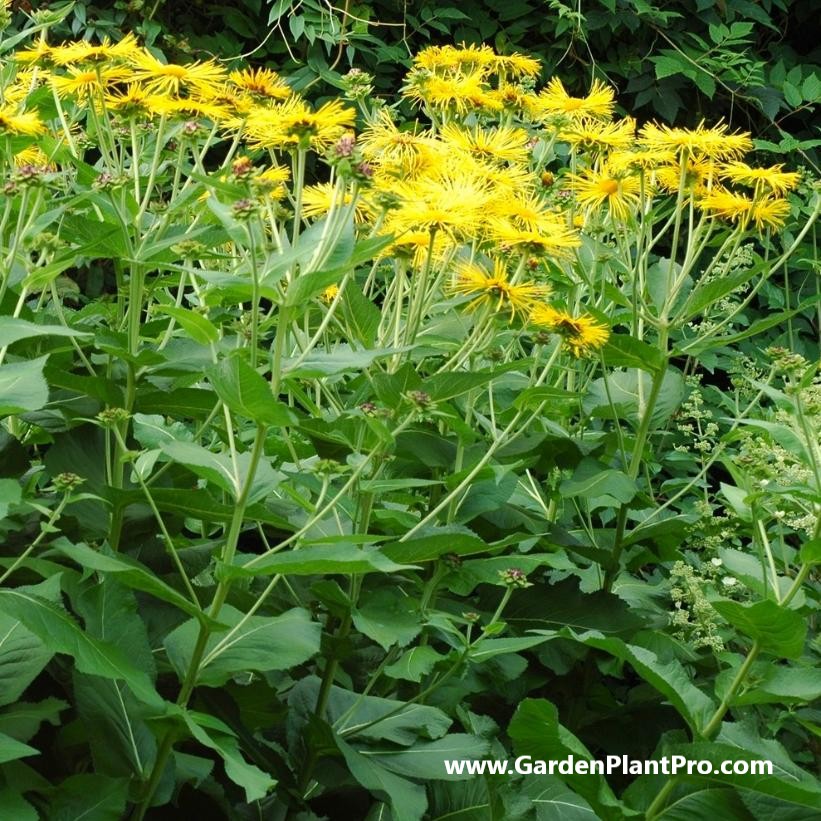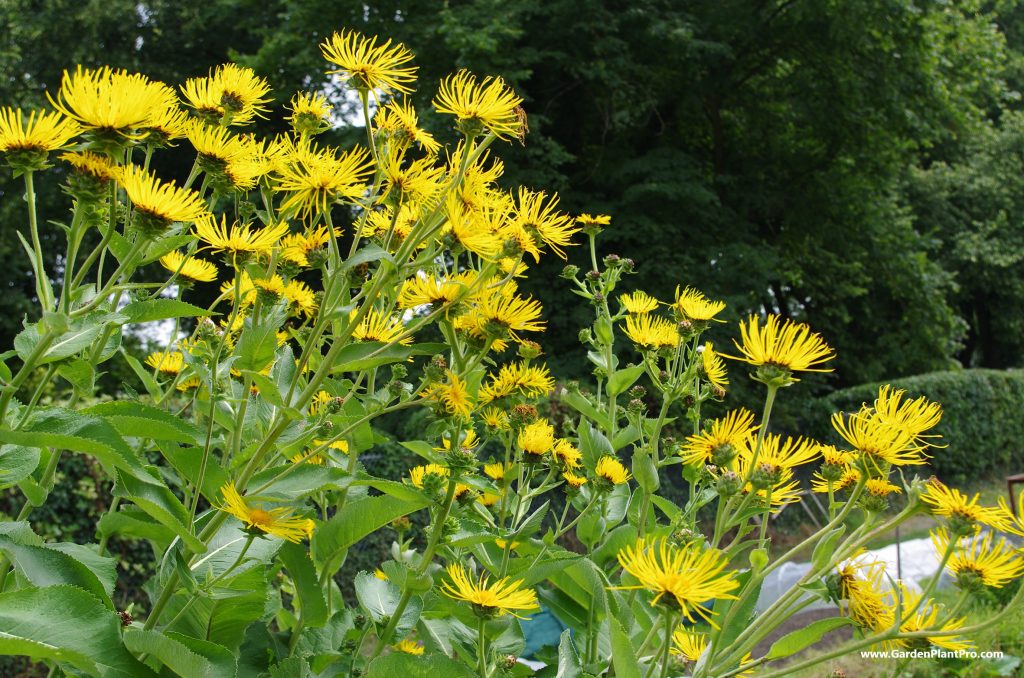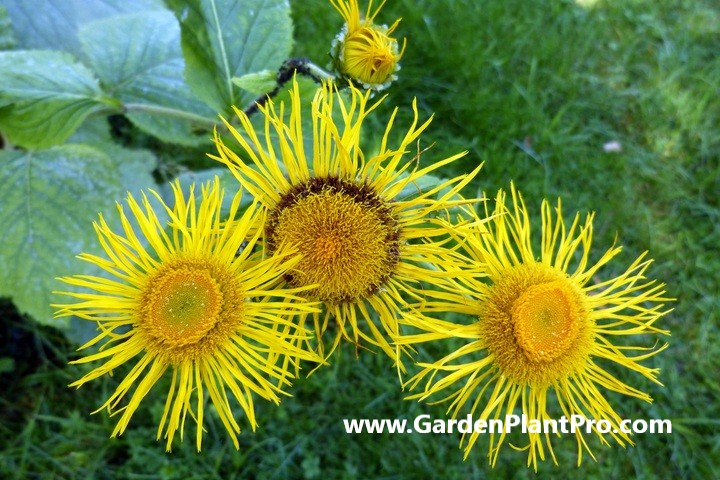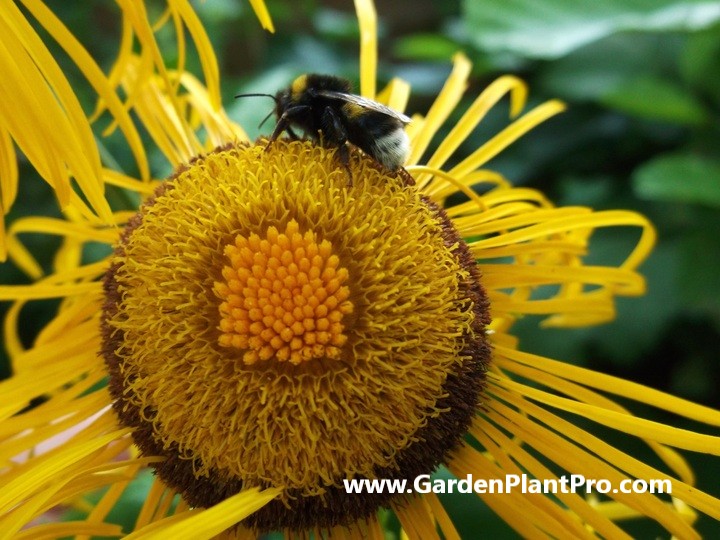Elecampane is a multi-purpose herb with medicinal and culinary properties that has been used for generations. This herbaceous plant is distinguished by its large, beautiful leaves and vivid yellow blooms, which bloom in midsummer. Growing elecampane in your own garden is a terrific way to give a distinctive flavor to your recipes while also reaping the advantages of its therapeutic properties.
In this guide , we’ll look at how to grow and use elecampane, from planting and care tips to delectable dishes that use this versatile herb. This guide will help you get started with growing and utilizing elecampane in your own backyard, whether you’re interested in herbal medicines or simply want to broaden your culinary horizons. Therefore, let us jump in and explore the delights of this little know herb.
A Brief History
Elecampane has a long history of use as a medicinal plant, with references to it being used as early as the ancient Greeks. In the Middle Ages, it was known for its healing properties, and was used to treat a variety of ailments including digestive problems, respiratory issues, and skin conditions.
The root of the plant is most commonly used for its healing properties and is thought to contain an array of active compounds that can help boost the immune system and provide relief from coughs and congestion. It has also been used to treat indigestion, constipation, and other digestive issues.
In addition to its medicinal uses, elecampane has also been used as a dye plant and for its culinary uses. The leaves have been used to make tea and the roots can be boiled or roasted for use in soups or stews.
Elecampane is also known for its ability to attract beneficial insects such as bees which helps to enhance biodiversity in the garden.
In recent years it has become increasingly popular in home gardens due to its ease of cultivation, low maintenance requirements, and attractive flowers. Knowing how to grow elecampane in your home garden can yield a variety of health benefits as well as beautiful flowers that attract beneficial insects.
Nutritional Benefits
Elecampane is a nutrient-dense herb that is rich in vitamins, minerals, and antioxidants. It is known for its many medicinal uses and is used to support intestinal worms, blood sugar, skin health, digestive health, and stress. It also has the potential to reduce fat and increase energy. Elecampane’s root also contains essential oils that have antioxidant, anti-inflammatory, and even potential anticancer properties.
Using elecampane as a dietary supplement can help to boost overall health and wellbeing. It can help to reduce inflammation throughout the body and support healthy digestion. Additionally, the plant can help to strengthen the kidneys and spleen according to Traditional Chinese Medicine (TCM).
Those looking to add elecampane root into their diet have several options. It can be made into a dried powder, loose tea, or liquid extract. Whole roots are also available and can be ground into a powder at home for personal use.
It is important to note that elecampane is not intended to replace medical advice or treatment for any health condition. Before adding any herbal supplement into your diet it is important to speak with a qualified healthcare professional first.

Common Varieties & Their Uses
Elecampane (Inula helenium) is a robust, upright perennial that is easy to grow and has a wide range of uses. It has many varieties and each offers its own benefits.
Common varieties of elecampane include:
• Inula helenium – This is the most common variety of elecampane. It is native to Europe, grows up to 5 feet tall, and has yellow flowers that bloom in mid-summer. The roots are long and thick, and have a spicy aroma.
• Inula britannica – This variety is native to Britain and grows up to 4 feet tall. Its flowers are white and it has a slightly different taste than the other varieties.
• Inula magnifica – This variety is native to India and grows up to 8 feet tall with deeply lobed leaves. Its flowers are yellow-orange and it has a very spicy flavor.
• Inula japonica – This variety is native to Japan and grows up to 3 feet tall with small yellow flowers. It has a mild flavor and is often used in teas or soups.
Elecampane can be used in many ways, from culinary uses such as soups or teas, to medicinal purposes such as digestion tonics or worming agents, to cosmetic purposes such as skin treatments or hair rinses. The root can be dried, powdered, or tinctured for use in herbal remedies or tonics. The leaves can be eaten raw or cooked, while the flowers can be steeped in honey for added flavor and nutrition.
When planting elecampane, it’s important to choose the right variety for your needs. If using for culinary purposes, then choose one of the milder varieties such as Inula japonica; if using for medicinal purposes then choose one of the spicier varieties such as Inula magnifica; if using for cosmetic purposes such as in skincare products or hair care treatments, then Inula helenium is the best choice due to its high concentration of essential oils.
When To Sow
When it comes to sowing elecampane, timing is key.
DIY PROJECT: Collect rainwater no matter where you live...
This DIY project is the best way to legally collect rainwater NO MATTER where you live. Get chlorine-free water, cut down on your water bills, and have enough for an emergency situation or to water your garden. Read More Here...
If you’re starting from seed, the best time to sow is in the late spring or early summer, when the soil has warmed up and is damp. If you’re transplanting seedlings, wait until the fall and harvest the root before propagating with cuttings.
Elecampane seeds should be sown on the surface and take anything from two to six weeks to germinate at 12 to 18 degrees centigrade (54 to 64°F). When the young Inula plants have sprouted two sets of leaves they are ready to be transplanted into the garden. Allow 18-24” between plants to provide ample space for leaf spread.
When choosing a location for your elecampane plants, look for an area with partial shade and well-drained soil. Make sure you prepare the soil ahead of planting, as elecampane prefers deep, rich, moisture-retentive soil in full sun or partial shade. If you’re planting in a windy area, you may need to provide some additional support for your plants.
Choose The Right Location
When it comes to choosing the right location for elecampane, make sure to pick a spot that provides plenty of sun for the plant to thrive.
Elecampane grows best in full sun to partial shade, in loamy, well-drained soil. It thrives in fertile soils and can tolerate some drought. While it is possible to grow elecampane in full shade, the plant will not reach its full potential without adequate sunlight. Additionally, elecampane can be grown in containers, making it easy to move the plant around to find just the right spot.
When planting elecampane outdoors, consider areas that are sheltered from strong winds and have good air circulation. This will help prevent the foliage from becoming too dry and brittle. When planting in containers, make sure to provide adequate drainage at the bottom of each pot. Good drainage helps prevent root rot and other issues caused by overly wet conditions.
Cottage gardens and wildflower meadows are excellent locations for growing elecampane, as they provide plenty of sunlight while still allowing some protection from strong winds. For those looking for a more formal look, elecampane can be planted along flower borders or beds. It is also possible to plant elecampane in areas with moist shady positions as long as the soil is well drained.
No matter what location you choose for your elecampane plants, make sure it receives enough sunlight and that the soil is well draining and rich in organic matter.
Prepare The Soil
Once the location has been chosen, it is important to prepare the soil for growing Elecampane. The soil should be a loamy, well-drained soil with a slightly acidic to neutral pH. A good fertility level is preferred, and so a top dressing of manure or compost should be added in the spring.
Digging or tilling the soil to loosen it up and remove any weeds or debris is also recommended. Finally, moistening the soil before planting will help ensure that the seedlings and plants get off to a healthy start.
Plant The Seeds Or Seedlings
Once you have chosen the right location and prepared the soil, it is time to plant the seeds, seedlings or cuttings of your elecampane.
When starting from seed, it is often best to start indoors so you can monitor them. Surface sow seeds and gently press into soil, as light aids germination. Make sure to keep the soil moist until seedlings emerge. Seeds will germinate in 14-21 days. Keep an eye on seedlings for signs of disease or pests before transplanting them outdoors. The young Inula plants should be spaced 12 inches apart.
Alternatively for those that prefer less maintenance, Elecampane seeds germinate relatively easily so can also be direct sown into your garden bed in late fall or early spring.
If using root cuttings, select a healthy piece of root that is about 2” long and contains a bud or eye. Plant each root cutting 12” deep and at least 12” apart. Water the area until the ground is moist, but not soggy.
Watering
When it comes to watering Elecampane, it is important to ensure that the soil is kept moist but not soggy. Watering should be done when the top 1-2 inches of soil are dry. Depending on the size of the pot and the amount of sun, Elecampane may need to be watered every 5-9 days. If the plant is placed in direct sunlight, it may need to be watered more frequently. An easy way to check if the plant needs water is to stick your finger into the soil. If it feels dry, then it’s time to water.
It is important to note that too much water can cause root rot and other diseases. To avoid this, make sure that there is good drainage in your soil or potting medium. Coarse textures can allow water to drain too rapidly, preventing the plant from taking up enough moisture.
If you’re growing Elecampane in a pot, make sure there are holes in the bottom for excess water to escape. Additionally, you may want to consider using a saucer or tray under your pot to catch any excess water and keep your plant from getting soggy.
Do you have some charcoal in your house right now? We call charcoal a “miracle leftover” for anyone who wants to be a little more self-sufficient and cut costs. That’s because it can help you with so many different things around the house and garden. You can even use it to make an energy-free fridge. Read More Here...
When you do water Elecampane, avoid getting the foliage wet as this can encourage fungal diseases. Instead, try using a watering can with a long spout or a soaker hose that will allow you to direct the water straight into the soil without wetting the foliage. Additionally, using lukewarm or room temperature water will help prevent shock from cold temperatures and help keep your plant healthy.
Fertilizing
Fertilizing is an essential part of growing and maintaining healthy Elecampane. For best results, a light application of a balanced fertilizer such as 10-10-10 should be applied every two years.
To increase root harvest, it is worth preparing the bed extra well to loosen up the soil if you are dealing with heavy clay. To keep weeds down and add nutrition to the soil, it is beneficial to cover the soil with a mulch of cocoa bean hulls.
When applying fertilizer, it is important to follow the manufacturer’s instructions for quantity, as too much fertilizer can damage the plant and even kill it. Start by mixing one part seed mix, three parts compost, and five parts clay. Stir it around with your hands and make sure all the small clumps are broken up. When the soil is ready for planting, lightly sprinkle the fertilizer around each plant in a circular motion about two feet away from the base of the plant. Water lightly after application.
It is also important to fertilize at the right time. If you are starting Elecampane from seed indoors, wait until they have been transplanted outside before applying any fertilizer. If you are planting directly into your garden, wait until plants have established themselves in their new location before fertilizing them. This will ensure that they have time to take root and establish themselves into their new environment before being exposed to additional nutrients.
By following these steps and using an organic fertilizer such as 10-10-10, you will ensure that your Elecampane plants not only grow strong and healthy but also provide you with an abundance of nutritious flowers, leaves, and roots that can be used for both culinary and medicinal purposes.

When & How To Harvest
Harvesting Elecampane is an important part of cultivating the plant. The roots should be harvested in the fall, when the plant has gone dormant. This works with the plant’s natural life cycle and ensures that the roots will be at their most potent.
To harvest, carefully dig around the base of the plant and loosen the soil. Then, gently pull up the roots and shake off any excess dirt. Cut off any leaves or stems that remain attached to the root.
Once you have harvested the roots, they should be immediately dried and stored in a cool, dark place. To dry Elecampane roots, spread them out on a cookie sheet or paper towel and let them sit in a warm spot in your home for a few days. Once dry, store them in an airtight container for up to a year.
Elecampane can also be propagated with cuttings from healthy pieces of root from 2-3 inches long. After harvesting the root, select a healthy piece and cut it into sections 2-3 inches long. Place these sections in a pot filled with moist soil mix and keep them in partial shade until they develop new shoots.
Elecampane has many nutritional benefits and is easy to grow at home. Careful harvesting is essential for ensuring that your Elecampane plants remain healthy and produce abundant harvests year after year. With proper care and harvesting practices, you can enjoy Elecampane’s many benefits for years to come.
Storing & Preserving
Storing & Preserving your elecampane harvest is an essential part of the process.
The most effective way to store and preserve elecampane is to tincture it.
To make a tincture from elecampane, you will need to chop the roots into small pieces and place them in a jar. Next, cover the roots with a high-proof alcohol such as vodka or brandy and seal the jar tightly. Store the jar in a cool, dark place for at least six weeks, shaking it every few days to help extract the medicinal compounds from the roots. After six weeks, strain the tincture through a cheesecloth or fine mesh strainer and transfer it to a dark glass bottle with a dropper. Your elecampane tincture is now ready to use!
Tincturing is a highly effective method of preserving the beneficial properties of elecampane, as the alcohol acts as a natural preservative and helps to extract the active compounds from the roots. It’s also a convenient way to use elecampane, as tinctures can be added to teas, tonics, and other herbal remedies for easy consumption.
Another method of preserving elecampane is by drying the leaf and stem material. Cut the stems just above ground level and trim off any discoloured or damaged leaves. Tie them into small bunches and hang in a dark, dry, airy place or spread them out on screens in a warm location. Once dry, store in an airtight container to keep away moisture and insects.
For seed harvesting, simply shake the seedheads into a bucket or strip the seedhead off when it’s ripe. Place in an airtight container and store in a cool, dry place until ready to use.
CASE STUDY: We've been living off the grid for the last 40 years...
In all that time an electric wire has never been connected to our house. We haven’t gotten or paid an electricity bill in over 40 years, but we have all the electricity we want. We grow everything we need, here, in our small backyard. We also have a small medicinal garden for tough times. Read More Here...
No matter which method you choose for storing elecampane, make sure to label your containers with the date of harvest and variety of plant so that you can easily identify them later on.

Common Diseases & How To Control Them
Elecampane is a hardy perennial herb that is relatively easy to grow in home gardens. However, it is important to be aware of common diseases that can affect the plant and to know how to control them.
Common diseases that can affect elecampane include root rot, mildew, and rust. To prevent and treat root rot, it is important to make sure that the soil drains well. If the soil stays wet for too long it can cause root rot. To prevent mildew, make sure the plants have enough air circulation and keep the leaves dry. Rust can be avoided by avoiding overcrowding when planting and providing good air circulation.
If any of these diseases do occur, there are treatments available. For root rot, improving drainage and removing infected plants is recommended. For mildew, pruning affected parts of the plant and applying a fungicidal spray can help control it. For rust, removing affected parts of the plant and applying a fungicidal spray will help control the spread of the disease
It is also important to avoid planting elecampane in areas where there have been outbreaks of these diseases in the past as this can make them more likely to occur again in future years.
Finally, regular monitoring of plants is important as this will help identify any signs of disease early on so they can be treated quickly before they become too severe. If any disease has been present in your garden before, it is important to take extra care when growing elecampane as these plants are very susceptible to certain diseases.
Common Pests & How To Control Them
Elecampane is a great addition to any garden, but like all plants, it can be susceptible to pests. Common pests include slugs, aphids, and caterpillars. To keep these pests at bay, you should practice regular garden maintenance.
Slugs can be deterred or eliminated by using baits or traps. A simple, effective trap is a shallow container filled with beer and buried slightly below ground level. Slugs are attracted to the beer and drown when they enter the container.
Aphids can be controlled by spraying with a mixture of insecticidal soap and water. This mixture can also help to deter other pests such as caterpillars. If the aphid infestation is severe, you may need to use a stronger insecticide such as neem oil or pyrethrin-based sprays.
Caterpillars can be controlled by handpicking from the plants or by using sticky traps. You can also use parasitic wasps to naturally control caterpillar populations in your garden. These wasps lay their eggs inside the caterpillar, and when hatched, the larvae consume the caterpillar from within.
Overall, keeping your Elecampane plants healthy will help to prevent pest infestations. Planting companion flowers and herbs such as marigolds or mint can also help to repel pests from your Elecampane plants and keep them healthy. Regularly checking for pests and taking preventive measures will help ensure that you have a healthy crop of Elecampane this season!
Companion Planting
Companion planting is a great way to maximize the health and productivity of your garden. When done correctly, it can help to improve pest control, increase pollination, and provide additional nutrients to your plants.
When planting with companions, it’s important to consider the different characteristics of each plant. Some plants will attract beneficial insects while some can act as a natural pesticide. Elecampane is an ideal companion plant for many vegetables due to its ability to repel aphids and other destructive pests. It can also provide shade for more delicate plants and help retain moisture in the soil.
Some of the vegetables that can benefit from planting elecampane nearby include tomatoes, peppers, cucumbers, and carrots. By improving soil health and repelling pests, elecampane can help these vegetables to grow stronger and healthier, resulting in a more bountiful harvest. Additionally, the presence of elecampane in the garden can help to increase biodiversity and promote a healthy ecosystem overall.
To get the most out of companion planting with elecampane, it’s important to plan ahead. Consider which vegetables you want to plant and how much space you have available. Some vegetables require more space than others, so you’ll need to plan accordingly. Once you’ve decided where you want to place each vegetable, choose an appropriate location for your elecampane that won’t interfere with other plants.
Companion planting doesn’t stop once you’ve planted your seeds or seedlings. As the plants grow and mature, you’ll need to ensure that they are receiving proper sun exposure and fertilization. It’s also important to keep an eye out for common diseases or pests that could affect the health of your garden. If you notice any signs of distress in either your elecampane or companion plants, take steps to address the issue quickly before it becomes a bigger problem.

Using Your Harvest
Once you have harvested Elecampane, it is important to consider how to best use the root. The roots of Elecampane can be dried and used as a powder or tincture in teas, tinctures and capsules. To dry the root, spread it out on a baking tray or in a dehydrator and allow it to air dry. The dried root can then be ground into a powder or used in other preparations.
The leaves of Elecampane can also be used for medicinal purposes. To dry the leaves, spread them out on a baking tray or in a dehydrator and allow them to air dry. Once dried, the leaves can be stored in an airtight container for up to one year. The leaves can then be brewed into a tea or infused into oil for topical use.
The flowers of Elecampane are edible and can be used as decorations on cakes and desserts. The flowers can also be added to salads for flavor and color. To preserve the flavor of the flowers, they should be dried by spreading them out on a baking tray or in a dehydrator and allowing them to air dry. The dried flowers should then be stored in an airtight container for up to one year.
Elecampane is also useful as an insect repellent due to its strong aroma. To make your own insect repellent, simply chop up the fresh root of Elecampane and add it to boiling water in a pot. Allow the water to cool before using it as an insect repellent spray around your garden area.
Finally, consider using Elecampane as an herbal dye for making fabrics such as wool, cotton and silk more colorful. To make your own dye from Elecampane, first chop up fresh roots into small pieces before adding them to boiling water in a pot with some alum mordant (available at many health food stores). Allow this mixture to cool before adding it to the fabric




